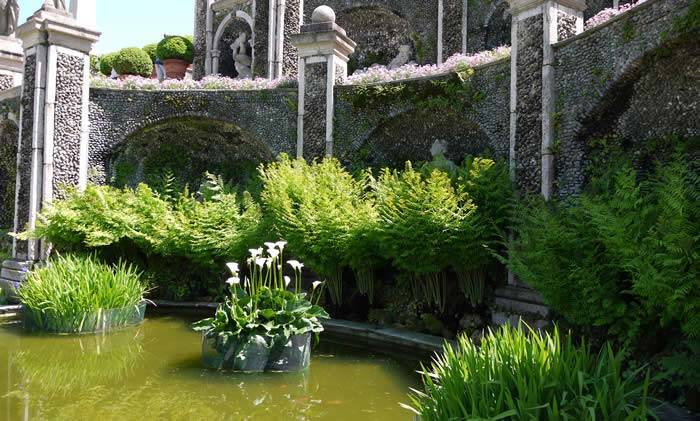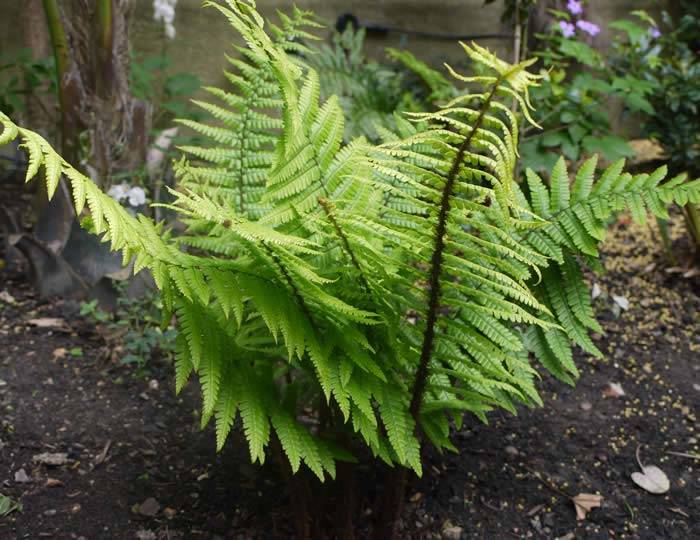Hundreds of millions of years old, ferns are among the most ancient of our flora. The fact that ferns don’t flower is more than made up for by their highly decorative fronds or leaves. Many ferns originated in woodland or densely forested areas where little sunlight could penetrate. Their resulting shade-loving characteristics make outdoor garden ferns one of the best plants to brighten up those shady or north facing areas of the garden where something green but nonetheless ornamental is required.

Ferns are an elegant solution when seeking plants for shade
Of course, for ferns to thrive in your garden you have to make sure that their basic needs are met. Here are the answers to the most common questions our customers have about caring for outdoor garden ferns:
How much sun does a fern need?
Outdoor garden ferns perform best in shade. While shady spots in the garden are ideal for growing ferns, they can also do well in dappled sun or partial shade. Too much sunlight, on the other hand, can be detrimental to these ornamental plants.
Where do ferns grow best?
In nature, ferns evolved in forests where thick canopies provided the shade they flourish in and the soil was rich enough to give them the nutrients they require. The situation is not much different for cultivated outdoor garden ferns: these plants grow best in shady spots and in organically rich soil that is moist but well-drained. To maintain consistent moisture in the soil, use mulch.
Are ferns easy to grow?
With the right care and optimal conditions, ferns are quite easy to grow. Their basic needs are undemanding. Outdoor garden ferns do not need much fussing over to thrive. We also have a good range of fully hardy native ferns that will survive winter frosts.
Do ferns come back every year?
Ferns are perennials- meaning that they will happily grow in your garden for years to come. For most outdoor garden fern varieties, some dieback is normal in the winter, especially if the temperatures are extremely low. If this happens, do not worry: in the spring, new fronds will emerge from the base. Most fern varieties tolerate freezing well and new growth is all but guaranteed. Permanent damage usually happens only in extreme circumstances.
Best Outdoor Garden Ferns for UK Climate
Asplenium Scolopendrium Angustatum (also known as Hart’s Tongue Fern) is a hardy evergreen fern with beautiful lime green leaves. It thrives in dappled shade. Hart’s Tongue Fern will eventually reach a maximum height and spread of 1 metre.
Doodia Media or Rasp Fern is a striking variety with brilliant red new growth that matures to dark green as the seasons pass. This unusual evergreen fern loves wet shade and is expected to reach a maximum height of 40 cm and spread of 1.2 metres.
Polystichum Setiferum Herrenhausen, or as it is more commonly known, the Soft Shield Fern is a variety native to Britain. Loved for its feathery, lace-like foliage, this highly-decorative garden fern does best in shady areas.
Dryopteris Affinis Pinderi or Pinder’s Golden Scaled Male Fern is a great choice if you prefer rosette style ferns. This adaptable and undemanding cultivar does equally well in sunnier spots as it does in shade and tolerates drier soils. Taller than most, it will grow to be circa 1 metre tall.
Award-winning outdoor garden ferns
Many ferns have received the Award of Garden Merit from the RHS (AGM) – this is a good indication that these plants will perform well in our UK gardens. Our selection of hardy outdoor garden ferns includes the following award-winning varieties:
Dryopteris Wallichiana, commonly known as Mr Wallich’s Fern, is a handsome fern with lime green fronds and black stems. It prefers shade and will tolerate a wide range of soils. Its expected size of up to 1.5 metres in width and height makes it a good choice for most gardens.
Athyrium Niponicum Var Pictum (Japanese Painted Fern) is particularly ornamental with its silver fronds. It will thrive in moist shade.
Cyrtomium Falcatum or the Japanese Holly Fern is recognisable for its unusual foliage: the arching fronds feature holly-shaped pinnae, hence the name. Fully hardy and compact (height of 60-90 centimetres and spread of 70 centimetres), it will look great in small and big gardens alike.
Polystichum Polyblepharum, also called Japanese Tassel Fern is a cultivar native to Japan. This ornamental fern is quite architectural and will thrive in moist shade. It will grow to be circa 60 to 90 centimetres in width and height.
A UK native, Matteuccia Struthiopteris or the Shuttlecock Fern, boasts vibrant bright green foliage that forms in the distinctive shuttlecock shape. A shade-loving variety, it will grow to be up to 75 centimetres high and wide.
Blechnum Spicant or Deer Fern is a native variety that boasts deep green upright narrow fronds and a neat habit. Ideal for narrow and compact shady spots in the garden, it will not grow over 50 centimetres in width and height. This variety is also suited for growing in containers.
Dryopteris Erythrosora or Japanese Copper Shield Fern is a semi-evergreen variety that got its name for the coppery pink young fronds. It prefers sheltered and dark locations and will grow to be around 60 centimetres high.
Polystichum Tsussimense, which also goes by Korean Rock Fern and Tsushima Holly Fern, is a variety prized for its purplish new fronds and black veins and black stems that contrast the dark green foliage once it matures. Compact in size, this low-growing fern has full height and spread of 10 to 50 centimetres.
Another rosette-type fern, Dryopteris Cycadina is also known as Shaggy Shield Fern or the Blackwood Fern. This low-growing variety won the RHS Perfect for Pollinators award- a testament to its appeal to beneficial garden critters. Its ultimate height and spread are around 1 metre.
Lots more on the Fern Section of our website! Our ferns are available to buy online (subject to a minimum order value of £50) or from our North London garden centre – open 7 days per week.

Ferns in a Japanese style Garden







